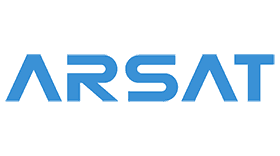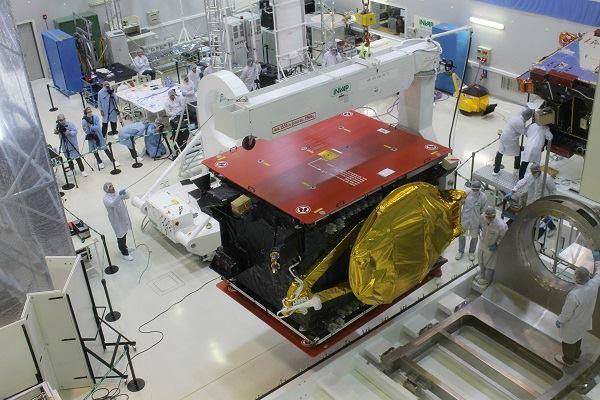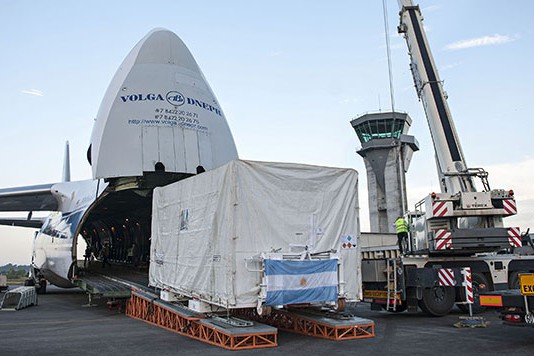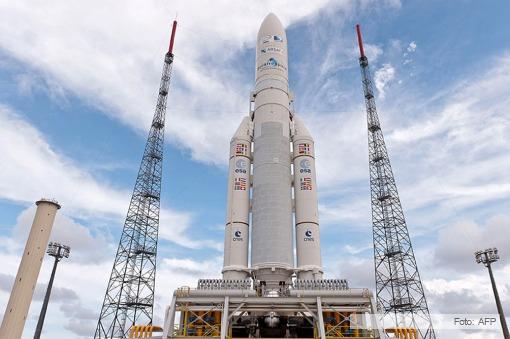
Back to selection

Supplier
ARSAT
ARSAT S.A.
Av. Juan D. Perón 7934
B1621 BGY
Benavidez PBA
Argentina
ARSAT is the satellite operator in Argentina and operates 2 satellites in orbit. A third satellite will be built and launched in 2023. ARSAT is headquartered in Buenos Aires, Argentina.
Thanks to the domestic manufacture of satellite technology, Argentina will have its own satellite and will not depend upon international operators to offer services within the country’s territory.
The ARSat-1 is Argentina’s first geostationary satellite built entirely with local parts. A crew of about 500 scientists built it over seven years at a cost of 250 million USD. The satellite was launched in October 2014 and will offer a wide array of telecommunications services such as television, telephony and Internet access with full coverage in Argentina, Chile, Uruguay and Paraguay.
With the construction and launch of the ARSat-1 satellite Argentina became one of the first Latin American countries to have produced a geostationary telecommunications satellite. Argentina joined an elite group that is able to build these types of satellites. Other nations with this capability include European Union states (SES, Eutelsat, HispaSat, HellaSat), the United States (Intelsat), Russia (RSCC, Gazprom Space Systems), China (ChinaSat by China Satellite Corporation), India (INSAT by ISRO), Israel (AMOS by SpaceCom), Korea (KTSat), Middle-East states (Arabsat, NileSat, TurkSat) and Japan (SKY Perfect JSAT).
ARSat-2 was Argentina’s second satellite. Built by INVAP S.E, the satellite was launched by launch operator Arianespace in September 2015. ARSat-2 satellite is mechanically identical as ARSat-1 but with different payload. ARSAT signed a contract in 2020 to construct ARSat-3 satellite. The satellite is planned for launch in 2023.
Company History
ARSAT was founded in 2006 as a strategic decision for the intelligent use of Government purchasing power by means of which the development of the ARSat-1 satellite was entrusted to Argentine technicians, engineers and scientists The decision fell within the commitment of the Argentine Government to support the leading role played by science and technology in social and economic development of the country.
Between 1975 and 1995, Argentina built and then dismantled South America’s most advanced ballistic missile program (Condor). Argentina first considered building an indigenous missile program in the 1970’s amidst border disputes with Chile and the United Kingdom. By the mid-80’s Argentina’s missile program had outpaced its nearest regional rival Brazil, and had also begun to attract funding and other support from Egypt and Iraq. By 1990, Argentina had produced numerous prototypes, but the country terminated its program just three years later in 1993.
The cancellation of the Condor Program in 1993 was the turning point for Argentina’s space efforts. Since its very beginnings, space research had been done by, or with support of, the armed forces. International pressure to end the medium range ballistic missile program also meant the dissolution or termination of most space related research in the country.
As a consequence, most space related matters were handed to the newly created space agency, CONAE, which was made independent of the Foreign Affairs Ministry, with a very strict mandate to only work on civil applications. At the same time, the ITU was in large-scale negotiations to assign orbital slots to each country.
As the space program was in disarray, with no experience in the geostationary communications market, the conundrum was assigned to the newly created National Telecommunications Commission (CNT for Comisión Nacional de Telecomunicaciones), the equivalent of the USA’s FCC, which was later turned into the current National Communications Commission (CNC for Comisión Nacional de Comunicaciones) in 1996.
Since orbital slot rights expire if not used within a certain time frame (usually three years), and given the economic crisis and general reorganization ongoing in the government by that time, it was decided to outsource the problem.
An international tender was made for the acquisition, launch and operation of a satellite to fill the slot that the country had negotiated, along with the construction of a ground station in the country from which the satellites would be operated.
The winning bid was made by a partnership that included Daimler Benz-Aerospace of Germany, Aerospatiale of France and Alenia Spazio of Italy, which formed a local company, NahuelSat S.A., to carry the business.
Initially NahuelSat leased Anik C1 from satellite operator Telesat Canada and was renamed as NahuelSat-I1 from May 1993 to March 1997, to keep the orbital rights to the 71.8° West slot. Anik C2, also oprated by Telesat Canada, was later leased as NahuelSat-I2. Meanwhile, a new satellite, Nahuel-1A, was ordered from Dornier Satellitensysteme (aka EADS Astrium aka Airbus Defense & Space), which was successfully launched on January 31, 1997 by launch operator Arianespace.
In 1998, the country acquired the rights to the 81° West orbital slot, in exchange for allowing DirecTV to operate in the country. It was also assigned to NahuelSat for exploitation. Unfortunately, the company never placed a new satellite there and only leased old satellites to hold on to the orbital rights.
To add insult to injury, the leased satellites didn’t broadcast in all the assigned frequencies, risking a lapse of the assigned rights. After this event, and given that Nahuel-1A was close to its end of life without a replacement ordered, the shareholders of NahuelSat S.A. accepted a transfer of the company and assets to the government-owned ARSAT in 2007, in exchange of the later taking care of all debts and obligations of the company shareholders.
ARSat-1
The ARSat-1 was the first of what has been planned to be three geosynchronous communication satellites (ARSat-1, -2 and -3) to be fully designed, built and tested in the country. The spacecraft was designed and manufactured with a mix of local and foreign supplier base. This mixture is a delicate balance between trying to combine mission risks while maximizing local experience and capabilities development.
The prime contractor is the leading space and nuclear technology company, INVAP S.E, wholly owned by the government of the Río Negro Province, which has acted as prime contractor and manufacturer for the whole series of scientific satellites. The final testing was and will be done at CEATSA, the newly created laboratory testing company.
ARSat-2
ARSat-2 satellite was built by INVAP S.E. in Argentina. The satellite was successfully launched by launch operator Arianespace in a dual launch with communications satellite Sky Muster I operated by NBN from Australia, using an Ariane 5ECA rocket on September 30th, 2015.
ARSat-3
In 2019 ARSAT signed a contract with launch operator Arianespace to launch their third satellite on an Ariane 5, but that satellite was never built. ARSAT renamed its planned third satellite to SG-1, short for Second Generation-1. The name change reflects a shift to high-throughput Ka-band capacity, all-electric propulsion and an increased use of Argentine subsystems.
The Argentine government, established in December 2019, finally agreed to finance the third satellite. ARSAT is planning to launch its third satellite in 2023.
All trademarks, logos and images mentioned and showed on this page are property of their respective owners.
Resources
www.arsat.com.ar
www.en.mercopress.com (edition 24th Oct 2014)
www.buenosairesherald.com (editions 16th & 17th Oct 2014)
www.embassyofargentina.us
www.nasaspaceflight.com
www.usatoday.com (edition 17th Oct 2014)
www.satbeams.com
www.nti.org
www.arianespace.com
www.youtube.com
www.spacenews.com edition March 19th 2020

Supplier
ARSAT
ARSAT S.A.
Av. Juan D. Perón 7934
B1621 BGY
Benavidez PBA
Argentina
Satellite fleet by ARSAT
| Spacecraft | Country | |||
| ARSat-1GEO | 72° West | ARSAT |  | Communication |
| ARSat-2GEO | 81° West | ARSAT |  | Communication |
| ARSat-SG1 (ARSat-3)GEO | 81° West | ARSAT |  | Communication |
| Nahuel-1AGEO | 71.8° West | ARSAT |  | Communication |


